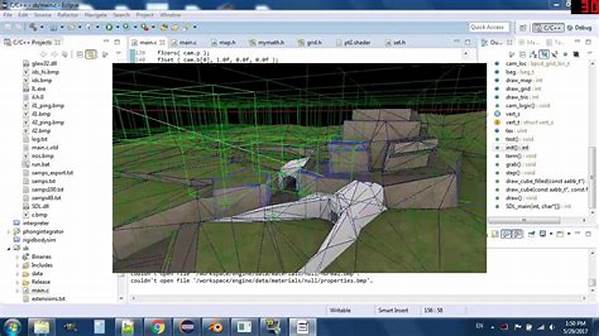Hey there, fellow tech enthusiast! If you’ve ever wondered about how your favorite games or simulations manage to keep tabs on objects colliding without tanking performance, you’re in for a treat. Enter the world of broadphase and narrowphase techniques, the unsung heroes lurking behind seamless virtual interaction. Let’s dive into these fascinating processes, unraveling their secrets and subtle beauty.
Read Now : Physics-driven Character Animations
Understanding the Basics
Broadphase and narrowphase techniques act as the dynamic duo in collision detection. Broadphase is like the friendly neighborhood watch, identifying potential collisions without the burden of intricate calculations. It sets up the scene by decluttering, filtering out objects that are unlikely to collide. Narrowphase, on the other hand, gets up close and personal. It provides a detailed analysis, focusing on objects flagged in the broadphase to determine if a collision truly occurs. This collaboration is essential for optimizing performance, ensuring real-time applications don’t skip a beat.
In broadphase, the primary aim is to utilize simpler calculations to quickly identify pairs of objects that might collide. This method can handle thousands of objects efficiently, serving as the first line of defense. Once potential collisions are flagged, narrowphase techniques get to work. They delve deeper, employing geometry and precise physics to verify collisions, portraying them with much-needed accuracy. Together, these techniques orchestrate a balance between speed and precision, bringing our digital realms to life without breaking a sweat.
Breaking It Down: Five Quick Insights
1. Broadphase techniques sift through countless objects, quickly ignoring those far apart, simplifying initial calculations.
2. Narrowphase techniques hone in on potential collisions, using detailed geometry checks for accuracy.
3. Broadphase could be thought of as setting the stage or drawing a map with viable paths.
4. Narrowphase is the detective work, confirming whether two objects indeed interact after broadphase beckons attention.
5. These techniques together keep computations lean and mean, crucial for real-time applications.
The Role of Broadphase
Imagine broadphase techniques as the maestro of orchestration, directing thousands of particles or objects in a scene with a simple wave of the baton. The point here is not to worry about the minute details. Instead, it’s to make sure those potential collisions are identified without bogging down the system. Think of broadphase as scanning a crowd for familiar faces – it’s quick and efficient. It sets everything up so narrowphase techniques can swoop in and inspect the details on those familiar faces. So, no unruly crowd management; broadphase streamlines anything remotely interesting to a manageable number for further analysis by narrowphase techniques.
These early filters help systems focus processing power, akin to sorting through emails by priority before tackling content. Broadphase serves as a sieve, allowing only the essentials to pass through, discreetly ensuring that complex intersections don’t throttle your processor. Whether it’s bounding volume hierarchies or grid-based approaches, broadphase techniques are instrumental in providing the initial sweep before objects dive deeper with narrowphase techniques into the intricate dance of collision detection.
Narrowphase in Action
Narrowphase techniques have one simple goal: precision. Whether breaking out the rulers or the magnifying glass, this phase demands accuracy. Picture it this way: broadphase says, “Heads up, we might have something interesting here!” and narrowphase gears up, ready to confirm or refute the encounter with painstaking detail.
1. Broadphase acts as a playbook; narrowphase as the full game analysis.
2. Narrowphase employs physics and math magic to clinch precise contact points.
3. Verification steps in narrowphase ensure all flag-worthy close calls are truthfully assessed.
4. This detective work can delve into actual intersection tests or displacement checks.
Read Now : **cultural Interaction Simulation Strategies**
5. Broadphase covers the ground, while narrowphase combs through flagged interests with a finetoothed brush.
6. Precision is the name of the game. Narrowphase is here for close encounters.
7. Expect narrowphase to use advanced computation. This phase leaves no stone unturned.
8. Broadphase and narrowphase techniques together are a powerhouse duo, their interplay crucial for functioning digital spaces.
9. The synergy between them evokes seamless integration, a ballet in digital arenas.
10. They streamline the workflow, ensuring both efficiency and insight in digital collision detection.
Putting It All Together
At first glance, the choreographed interplay between broadphase and narrowphase techniques might seem simple, but there’s elegance in their execution. They meld intuition with analytical prowess, sensitive to context while demanding proficiency. In practice, the mechanisms deployed by broadphase – think spatial partitioning or sweep and prune methods – single out potential interactions. Narrowphase then steps in, ensuring these candidates are scrutinized for closer contact analysis, utilizing geometry and even considering time of impact. Such tasks might sound intricate, but together, broadphase and narrowphase techniques weave an intricate dance, optimized for handling complexity. They are as integral as the software ecosystems they operate in.
Developers routinely lean on this bundle of solutions to scale great heights in game development, physics simulations, and more. This symbiosis allows poignant, fluid interactions within virtual environments, maximizing efficiency and resource allocation. Our favorite polygons, these gaming worlds we cherish, owe much of their seamless freedom to the sophistication of broadphase and narrowphase techniques. They provide the stable foundation upon which smoother, faster, and more realistic experiences continually blossom.
Unlocking New Possibilities
These broadphase and narrowphase techniques are pivotal, ensuring the seamless integration between multiple moving parts within digital worlds. The blend of predictive precision and scrutinized verification carves a niche that’s both efficient and effective. As developers push the boundaries further, the dance between broadphase and narrowphase persists as a critical theme. Ever-evolving, these strategies encapsulate the mechanisms of system optimization, serving as core techniques for crafting realistic experiences in virtual interactions.
Their application extends beyond gaming, even impacting real-time simulations and potentially AI as it learns to engage with dynamic surroundings. Throughout the digital realm, broadphase and narrowphase techniques markedly enhance the gameplay, ensuring fluid interaction within limitless potential. Amidst emerging tech trends, we can expect these techniques to maintain their relevance, morphing and adapting as virtual and augmented reality really take off. They are the unsung architects, balancing complexity with immediacy, creating oversees the vast, interconnected matrices that define our digital landscape.
Closing Thoughts
In wrapping up this exploration, broadphase and narrowphase techniques epitomize the elegance of digital engineering. They exist as problem solvers, sidelining inefficiencies while championing fluidity and accuracy. This deep dive into the mechanics underscores the importance of cooperation and efficiency in tech. In essence, these synchronized processes illuminate a world striving towards perfection, balancing the brute force of broadphase and the fine-tuning prowess of narrowphase techniques.
Think of this duo as the unsung orchestrators of your digital experiences. As you play that favorite game or engage with interactive simulations, take a moment to appreciate the intricacies woven in behind the scenes. The harmony they create reverberates across the realms of technology, continuing to empower dynamic and seamless digital evolution. Here’s to the seamless simulations and interactive escapades brought to life, courtesy of broadphase and narrowphase techniques!





